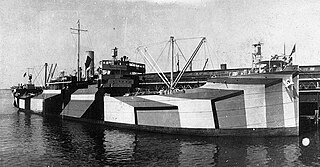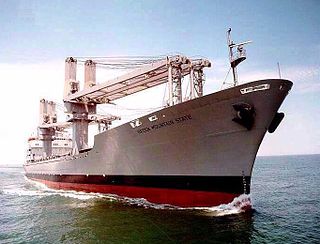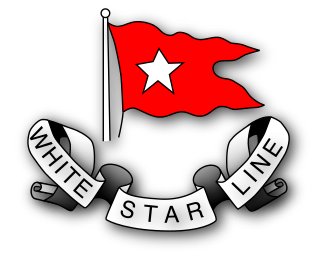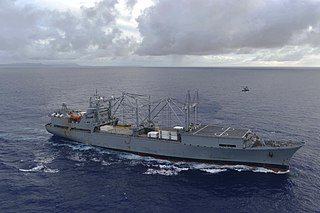
The New York Shipbuilding Corporation was an American shipbuilding company that operated from 1899 to 1968, ultimately completing more than 500 vessels for the U.S. Navy, the United States Merchant Marine, the United States Coast Guard, and other maritime concerns. At its peak during World War II, NYSB was the largest and most productive shipyard in the world. Its best-known vessels include the destroyer USS Reuben James (DD-245), the cruiser USS Indianapolis (CA-35), the aircraft carrier USS Kitty Hawk (CV-63), the nuclear-powered cargo ship NS Savannah, and a quartet of cargo-passenger liners nicknamed the Four Aces.

HMAS Warrego (L73/U73), named for the Warrego River, was a Grimsby class sloop of the Royal Australian Navy (RAN).

MS Birger Jarl is a cruise ship owned by Ånedin Linjen that was operated on services between Stockholm, Sweden and Helsinki, Turku and most recently Mariehamn on the Åland Islands (Finland). She was built in 1953 as a passenger liner at Finnboda shipyard in Nacka, Sweden as SS Birger Jarl for Rederi AB Svea. In 1973 she was sold to Jakob Lines, was renamed SS Bore Nord and converted into a ferry. In 1978 she was bought back by the Ånedin Line and was renamed SS Baltic Star. In 1982 the ship's original steam engines were replaced by diesel engines; the ship's prefix hence altered to MS. In 1989 the engines were again replaced by new diesels. In 2002 the ship reverted to the name Birger Jarl.

USS Mizar (AF-12) was a United Fruit Company cargo and passenger liner that served as a United States Navy Mizar-class stores ship in World War II.

USS General Omar Bundy (AP-152) was a General G. O. Squier-class transport ship for the U.S. Navy in World War II.

SS Prinz Friedrich Wilhelm was an ocean liner for North German Lloyd (NDL) from her launch in 1907 until the end of World War I. After the war, she briefly served as USS Prinz Friedrich Wilhelm (ID-4063) for the United States Navy returning American troops from France. The vessel was first chartered—and later purchased outright—by Canadian Pacific Steamships (CP) and operated under the names Empress of China, Empress of India, Montlaurier, Monteith, and Montnairn. She was scrapped in 1929.

The Type C4-class ship were the largest cargo ships built by the United States Maritime Commission (MARCOM) during World War II. The design was originally developed for the American-Hawaiian Lines in 1941, but in late 1941 the plans were taken over by the MARCOM.

Komagata Maru was a steamship owned by the Shinyei Kisen Goshi Kaisya of Japan. She was built as a cargo ship in 1890 and had previously been known as both SS Stubbenhuk and SS Sicilia while sailing for two different German owners. She was later renamed Heian Maru.

Northwest Steel was a small shipyard in Portland, Oregon. Little is known of its background or owners, but during World War I the yard built cargo ships for the United States Shipping Board (USSB). Some 37 of the 46 ships ship built at Northwest Steel were the West boats, a series of 5,500-gross register ton (GRT) steel-hulled cargo ships built for the USSB on the West Coast of the United States as part of the World War I war effort.

SS Mauna Loa was a steam-powered cargo ship of Matson Navigation Company that was sunk in the bombing of Darwin in February 1942. She was christened SS West Conob in 1919 and renamed SS Golden Eagle in 1928. At the time of her completion in 1919, the ship was inspected by the United States Navy for possible use as USS West Conob (ID-4033) but was neither taken into the Navy nor ever commissioned.

BAP Abtao (SS-42) was a Abtao-class submarine of the Peruvian Navy.

SS Diamond State (T-ACS-7) is a crane ship in the NDRF for the United States Navy. The ship was named for the state of Delaware, which is also known as the Diamond State.

SS Green Mountain State (T-ACS-9) is a crane ship in ready reserve for the United States Navy. The ship was named for the state of Vermont, which is also known as the Green Mountain State.

SS Beaver State (T-ACS-10) is a crane ship in ready reserve for the United States Navy. The ship was named for the state of Oregon, which is also known as the Beaver State.

SS Gallic was a cargo steamship built in 1918. During her career, she had six different owners and sailed under the flags of the United Kingdom, Panama and Indonesia. In spite of prevailing maritime superstition that it is unlucky to change a ship's name, she underwent seven name changes and survived a 37-year career unscathed. She was scrapped at Hong Kong in 1956, the last surviving White Star Line cargo ship.

SS Cape Gibson (AK-5051) is a Cape G Class Break bulk cargo ship of the United States Maritime Administration, last used as a training ship at Texas A&M University at Galveston. Currently she later mothballed in the Beaumont Reserve Fleet.

The SS Rutland Victory was a Victory ship built during World War II under the Emergency Shipbuilding program. It was built and launched by the Oregon Shipbuilding Corporation on May 9, 1944, and completed on May 29, 1944. The ship's United States Maritime Commission designation was VC2-S-AP3 and hull number 104 (1020). The ship was Oregon Shipbuilding Corporation's 20th victory ship. The Maritime Commission turned it over for Merchant navy operation to a civilian contractor, the United States Lines.

The Type C5 ship is a United States Maritime Administration (MARAD) designation for World War II breakbulk cargo and later a container ship for containerization shipments. The first type C5 class ship was a class of ships constructed and produced in the United States during World War II. The World War II C5 class ship was dry bulk cargo ship built by Bethlehem Steel in Sparrows Point, Maryland. Bethlehem Steel built 8 ship in this bulk cargo class and four orders were canceled. The C5 class ship has a DWT of 24,250 and was 560 feet long. The C5 was mainly used as iron ore carriers. The C5 was needed to replace other ships that sank during WW2. First in her class was the SS Venore, USMC #1982, delivered on 20 July 1945. Type C5 class ship designed to fill the need to move iron ore from Santa Cruz, Chile, to Sparrows Point, Md., through the Panama Canal, a round-trip trip 8700 nautical miles.
Post World War 2 four ships were given C5 class type C5-S-78a, these were roll-on/roll-off container ship built by Ingalls Shipbuilding, Inc. of Pascagoula, Mississippi and operated by the Moore-McCormack Lines. The C5-S-78a had a deadweight of 16,000 tons.

The Type R ship is a United States Maritime Administration (MARAD) designation for World War II refrigerated cargo ship, also called a reefer ship. The R type ship was used in World War II, Korean War, Vietnam War and the Cold War. Type R ships were used to transport perishable commodities which require temperature-controlled transportation, such as fruit, meat, fish, vegetables, dairy products and other foods. The US Maritime Commission ordered 41 new refrigerated ships for the US Navy. Because of the difficulty of building refrigerated ships only two were delivered in 1944, and just 26 were delivered in 1945 and the remainder in 1946–48. The 41 R type ships were built in four groups. Two of design types were modified type C1 ships and two were modified type C2 ships. The United Fruit Company operated many of the R type ships in World War II. The type R2-S-BV1 became the US Navy Alstede-class stores ship and the type R1-M-AV3 became the US Navy Adria-class stores ship.


















